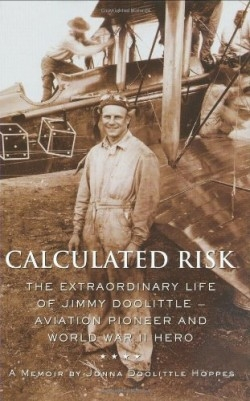Calculated Risk
The Extraordinary Life of Jimmy Doolittle Aviation Pioneer and World War II Hero
While testing a Hawk airplane for exhibition maneuvers at the 1929 Cleveland Air Races, ace speed pilot Jimmy Doolittle performed a loop that almost ripped the wings off the ill-equipped plane he was flying. Despite his efforts to get the craft under control by yanking the throttle back to pull it out of a dive, he was thrown from the plane.
His first attempt to open his parachute failed and “small moth wings of fear beat in his chest as he spiraled downward.” With only 1,000 feet remaining before impact, he gave the parachute a good hard pull, with the result that he could report his dissatisfaction with the nascent United States Air Corps’ maintenance of its planes. His succinct report to the Irvin Parachute Company was a bit more positive: “Airplane failed. Parachute worked.”
The author uses this type of storytelling to detail the life of her grandparents, Doolittle and his wife, Josephine, nicknamed “Joe.” Hoppes teaches classes at the United States Air Force Base in Los Angeles, and has published articles in Smithsonian Air and Space Magazine. Here, she tells the story of not just a pilot, but a husband and father, and two truly adventurous hearts. The couple’s life together is fleshed out through letters, photographs, and the details of Doolittle’s contributions to aviation history and the U.S. military, in which he became a general. He completed the first crossing of the United States in less than twenty-four hours’ time in 1922, and was awarded the Congressional Medal of Honor. Jimmy and Joe traveled the world as ambassadors of flight, and he worked for the Guggenheim Fund and Shell Oil promoting the development of better fuels for planes and commercial aviation.
Beyond simply inventorying accomplishments and successes, Hoppes portrays Doolittle’s humble beginnings in Alaska, his courting of Joe, plane failures, competitions, and her grandfather’s general frustration with bureaucracy. He witnessed the buildup of German “commercial” aviation after World War I, noticing that the planes could easily be converted to military aircraft (violating the Treaty of Versailles.) This memoir provides a personal account of Doolittle and the incredible support he received from his wife, whose hair was prematurely grayed by her husband’s love of risk, and who emerges as an equally strong character.
In 1929, after Jimmy had successfully completed the first blind flight (using only instruments to take off, fly, and land), he and Joe hosted a dinner party, after which Joe asked the guests to sign her tablecloth. She then embroidered the names, (including a Guggenheim, Jack Dalton, Captain Jerry Land) to preserve them. The tablecloth now hangs in the National Air and Space Museum in Washington, D.C., as testament to pioneers of flight and major players in U.S. aviation history.
Reviewed by
Kristin Putchinksi
Disclosure: This article is not an endorsement, but a review. The publisher of this book provided free copies of the book to have their book reviewed by a professional reviewer. No fee was paid by the publisher for this review. Foreword Reviews only recommends books that we love. Foreword Magazine, Inc. is disclosing this in accordance with the Federal Trade Commission’s 16 CFR, Part 255.

